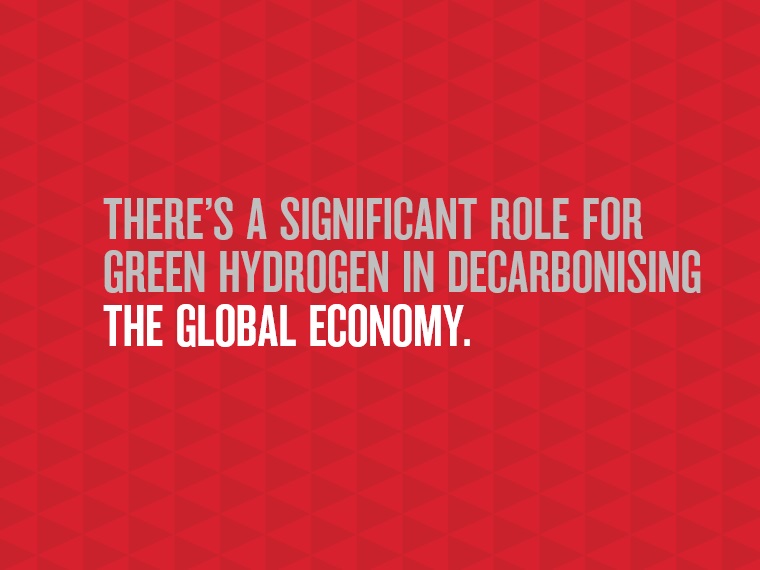Robust growth for online retail sales observed in June


Insight
Hydrogen holds great promise in decarbonising hard-to-abate sectors in the transition to a low carbon economy, as Australia’s trading partners ramp up their commitments to net zero.

Australia is well placed to become a major producer of green hydrogen as the global market develops to harness energy from the world’s most abundant element. To get there, financiers and investors need to focus on the most viable applications for hydrogen.
“There’s a significant role for green hydrogen in decarbonising the global economy, energy and power systems, but what does it actually mean to go down this pathway?” said Lachlan Shaw, Head of Commodity Research, Markets, at NAB. “There are a lot of big claims being talked about some of the potential applications and we need to start with the basics.”
Currently, demand for hydrogen is mainly limited to its use as an industrial feedstock that relies on “grey” hydrogen, meaning it’s generated from fossil fuels that release carbon dioxide emissions into the atmosphere.
A transition to clean or “green” hydrogen production requires electrolysis of water, powered by renewable electricity, that effectively has zero carbon emissions and oxygen as the only by-product. A third option being discussed is “blue” hydrogen, which is still produced with fossil fuels but uses carbon capture and storage to almost eliminate emissions.
“Industry is where the biggest opportunity lies as we sit here today,” said Shaw. “Hydrogen has the best prospects for decarbonising hard-to-abate sectors such as steel, aluminium, chemicals and parts of the heating and power systems.”
There is growing global momentum towards the goal of net zero emissions. We’re also seeing some of Australia’s major trading partners announce ambitious new emissions reduction targets by 2030[1]
Hydrogen is seen as a strong contender for enabling the shift to a low-carbon world.
“The hydrogen industry is at its formative stages,” said Fiona McIntyre, NAB’s Global Head of Energy & Utilities. “It has significant potential beyond its current uses, and the developing market has exciting prospects for large-scale, clean hydrogen.”
There are more than 60 pilot or demonstration hydrogen projects under way around Australia, including about 12 under construction[2].
State funding and federal government support from the Australian Renewable Energy Agency (ARENA) to date has totalled over A$800 million, via a mix of partial grants and loans to build large-scale electrolysers and other projects[3]. In May, ARENA conditionally approved $103.3m in funding for three commercial-scale renewable hydrogen projects with Engie, ATCO and Australian Gas Networks.
Ahead of the federal budget in May, the federal government promised a further A$275 million to develop regional production hubs for hydrogen under its technology roadmap.
Using renewables in the hydrogen production process is key, and here Australia has a competitive advantage with abundant natural resources and land for wind and solar farms.
“Australia has some of the best solar and wind resources globally,” said McIntyre.
The National Hydrogen Strategy[4] aims for Australia to become one of the top three exporters of hydrogen to Asian markets, building on a long history of exporting energy commodities to Asia, and CSIRO estimates demand in Asia could reach 3.8 million tonnes in 2030. Japan and South Korea, whose economies depend heavily on imported fossil fuels, have set ambitious plans to switch to imported green hydrogen.
“Hydrogen will become a significant export story. Australia is a stable supplier of energy commodities, close to demand in Asia and with decades of energy export experience,” said McIntyre.
While hydrogen “bulls” propose a range of applications including transportation, heat and power, challenges in storing and transporting the lightest element mean not all applications will be economic.
“The very first step the industry needs to take is turning existing hydrogen production globally and converting that to green,” said Shaw. Hydrogen used for industrial feedstock and oil and gas refining currently accounts for 2.5-3% of global carbon emissions, according to the International Energy Agency.
“This is where most effort should be focused in the short term. If we were to convert today’s hydrogen from grey to green, we would reduce 2.5-3% of global CO2.
“If you then convert global steel production to green hydrogen — steel accounts for about 7-8% of global CO2 — that would total 10% of global CO2 emissions that you sequester in two applications. It’s a huge opportunity,” he said.
Shaw believes that some proposed applications for hydrogen power such as passenger cars and medium-haul trucking are less viable because it takes as much as three times the renewable electricity to power a hydrogen fuel cell vehicle versus an electric battery vehicle.
Trade may take years to develop as hydrogen is extremely difficult to store and transport because of its low energy content per unit of volume. Liquefying hydrogen for transport uses up 30% of its contained energy, and then the liquid form needs to be stored at minus 250 degrees celsius.
Instead, using green hydrogen in the production of green ammonia is more cost effective for storage and transport as the world already has an ammonia supply chain. It also supports Japan’s strategy of converting power capacity to green ammonia fired instead of natural gas or coal, and will provide new opportunities to develop an ammonia export industry for Australia.
[1] https://www.whitehouse.gov/briefing-room/statements-releases/2021/04/22/fact-sheet-president-biden-sets-2030-greenhouse-gas-pollution-reduction-target-aimed-at-creating-good-paying-union-jobs-and-securing-u-s-leadership-on-clean-energy-technologies/
[2] https://www.csiro.au/en/work-with-us/services/consultancy-strategic-advice-services/csiro-futures/futures-reports/hydrogen-roadmap
[3] https://arena.gov.au/
[4] https://www.industry.gov.au/sites/default/files/2019-11/australias-national-hydrogen-strategy.pdf
© National Australia Bank Limited. ABN 12 004 044 937 AFSL and Australian Credit Licence 230686.